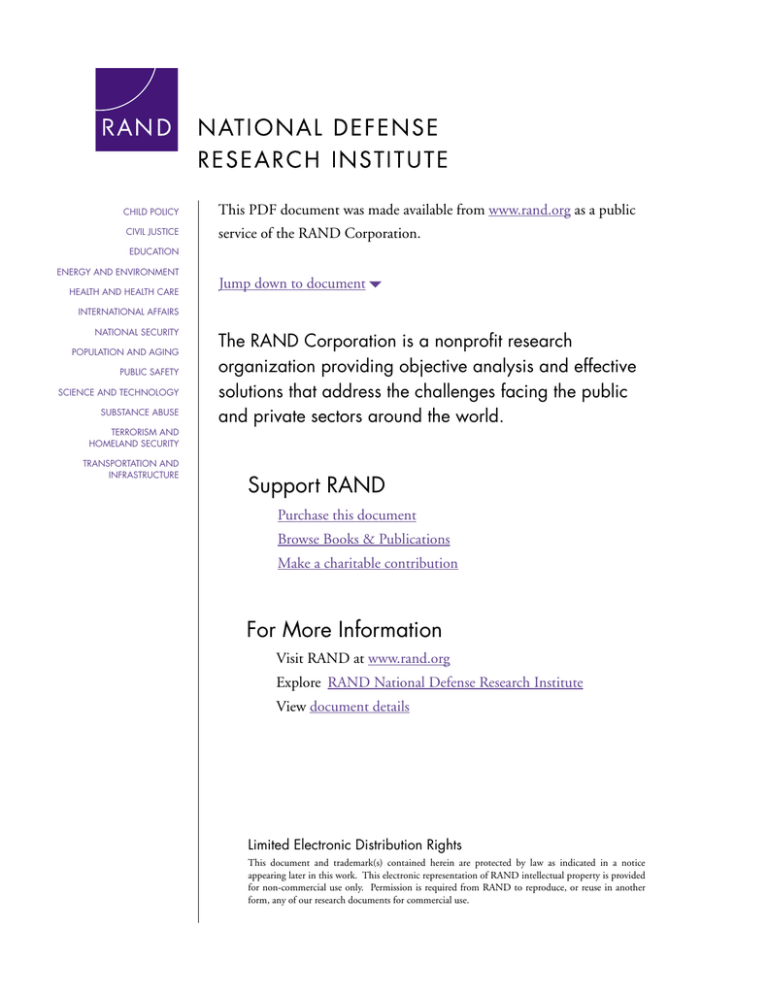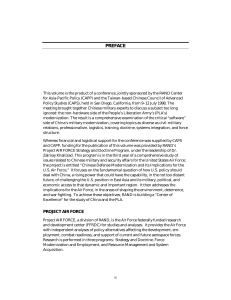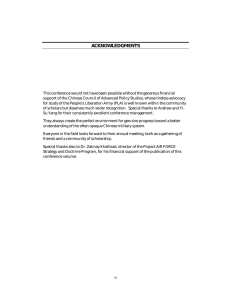
CHILD POLICY
CIVIL JUSTICE
This PDF document was made available from www.rand.org as a public
service of the RAND Corporation.
EDUCATION
ENERGY AND ENVIRONMENT
HEALTH AND HEALTH CARE
Jump down to document6
INTERNATIONAL AFFAIRS
NATIONAL SECURITY
POPULATION AND AGING
PUBLIC SAFETY
SCIENCE AND TECHNOLOGY
SUBSTANCE ABUSE
TERRORISM AND
HOMELAND SECURITY
TRANSPORTATION AND
INFRASTRUCTURE
The RAND Corporation is a nonprofit research
organization providing objective analysis and effective
solutions that address the challenges facing the public
and private sectors around the world.
Support RAND
Purchase this document
Browse Books & Publications
Make a charitable contribution
For More Information
Visit RAND at www.rand.org
Explore RAND National Defense Research Institute
View document details
Limited Electronic Distribution Rights
This document and trademark(s) contained herein are protected by law as indicated in a notice
appearing later in this work. This electronic representation of RAND intellectual property is provided
for non-commercial use only. Permission is required from RAND to reproduce, or reuse in another
form, any of our research documents for commercial use.
This product is part of the RAND Corporation conference proceedings series. RAND
conference proceedings present a collection of papers delivered at a conference. The
papers herein have been commented on by the conference attendees and both the introduction and collection itself have been reviewed and approved by RAND Science
and Technology.
China on the Move
A Franco-American Analysis
of Emerging Chinese Strategic
Policies and Their Consequences
for Transatlantic Relations
David C. Gompert, François Godement,
Evan S. Medeiros, James C. Mulvenon
Sponsored by the Office of the Secretary of Defense and Centre Asie Ifri
Approved for public release; distribution unlimited
The research described in this report was sponsored by the Office of the Secretary of Defense
(OSD) and Centre Asie Ifri. The research was conducted in the RAND National Defense
Research Institute, a federally funded research and development center supported by the
OSD, the Joint Staff, and unified commands, and the defense agencies under Contract
DASW01-01-C-0004.
ISBN: 0-8330-3676-9
The RAND Corporation is a nonprofit research organization providing objective analysis
and effective solutions that address the challenges facing the public and private sectors
around the world. RAND’s publications do not necessarily reflect the opinions of its research
clients and sponsors.
R® is a registered trademark.
© Copyright 2005 RAND Corporation
All rights reserved. No part of this book may be reproduced in any form by any electronic or
mechanical means (including photocopying, recording, or information storage and retrieval)
without permission in writing from RAND.
Published 2005 by the RAND Corporation
1776 Main Street, P.O. Box 2138, Santa Monica, CA 90407-2138
1200 South Hayes Street, Arlington, VA 22202-5050
201 North Craig Street, Suite 202, Pittsburgh, PA 15213-1516
RAND URL: http://www.rand.org/
To order RAND documents or to obtain additional information, contact
Distribution Services: Telephone: (310) 451-7002;
Fax: (310) 451-6915; Email: order@rand.org
SUMMARY
China and the International Security Environment
China’s international security environment has changed significantly since September 11,
2001. Regions vital to China, such as South Asia, Southeast Asia, and Central Asia, have
emerged as nodes of instability. U.S. global military presence has dramatically expanded,
and U.S. willingness to intervene, where and when it wants to protect U.S. interests, is on
the rise.
Following 9/11 and the U.S. war on terrorism, the tone and content of U.S.-China
relations have changed dramatically. U.S. policymakers now talk about maintaining a
cooperative, candid, and constructive relationship with China. U.S. and Chinese
policymakers alike have indicated a strategic shift in their willingness to seek
opportunities for cooperation and to manage traditional problems in U.S.-China relations.
Considering its strategic environment--above all, the strong position of the United States
and the insecurity of regions of special interest--China has several basic options:
•
•
•
•
Attempt to counter U.S. power politically, economically, and militarily.
Pursue political cooperation with the United States in current circumstances while
building Chinese military power with a view toward countering U.S. influence in
the long term.
Pursue long-term political cooperation with the United States while building
Chinese military power.
Pursue long-term political cooperation with the United States without building
Chinese military power.
Of these scenarios, the last appears to be counterfactual, in that China is building its
military power. As long as the Chinese economy remains healthy, it is therefore unlikely
that China would abandon its effort to acquire military capabilities that match its
political-economic status and regional security needs and also strengthen its bargaining
position vis-à-vis the United States. While the United States may try to dissuade China
from pursuing certain directions in its military modernization effort, it is unlikely to
succeed.
The two most likely scenarios are lasting cooperation and tactical cooperation, with
continued expansion of China’s military power. The best available option, from a
Western standpoint, is obviously for China to pursue lasting cooperation even as its
power expands.
vii
Chinese Policy Reactions to Changes in the International Security Environment
Chinese diplomacy has undergone an important evolution over the last decade. Beginning
in the mid-1990s, Beijing’s foreign policy began to reflect a more sophisticated,
confident, less confrontational, and more proactive approach toward regional and global
affairs. These trends are reflected in China’s increased engagement with multilateral and
regional security organizations, and Beijing’s growing attention to nontraditional security
challenges. These changes are likely to endure over the next several decades.
In recent years and especially after 9/11, some particularly innovative thinking about
China’s role in world affairs has emerged. Chinese analysts have argued for the adoption
of a “great-power mentality” to replace Beijing’s view of itself as a victim of the
international system. In addition, these analysts assert that China needs to more closely
associate with the interests of great powers, and that China as a rising power needs to pay
attention to its responsibilities as a great power.
China has reacted in numerous specific ways to the recent changes in its international
security environment. Beijing has cooperated with the international community in
fighting terrorism, combating weapons proliferation, and in stabilizing South Asia. China
has led an effort to foster security dialogues with nations in Central and Southeast Asia.
In particular, Beijing has increasingly sought opportunities to cooperate with the United
States in managing these numerous global security problems. Chinese leaders appear to
have decided not to pursue “external balancing” against United States presence in Asia.
China’s Military Priorities
The changes in the international security environment have had a profound impact on the
threat perceptions of the People’s Liberation Army (PLA) and its civilian masters,
creating bureaucratic and political support for accelerated military modernization. For the
PLA, two of the most important perceived changes were the rise of dominant U.S.
military power, as evidenced in Gulf Wars I & II, Kosovo, Afghanistan, and Iraq and the
evident desire on the part of the sole remaining superpower to use that military power to
pursue a global unilateral agenda.
These changes in PLA perceptions have also significantly shaped the trajectory of its
military buildup and rapid acceleration of equipment upgrades and doctrinal revision that
had heretofore been relatively gradual. Beginning in the early 1990s and accelerating
after 1999, PLA modernization was elevated from a relatively low priority to a core
element of national policy.
The goals of this modernization effort are to fill niche capabilities with high-tech
acquisitions from Russia while the PLA undergoes massive internal reform in key areas
such as education, training, organization, and doctrine. More recently, two decades of
wrenching change in the Chinese defense industries have begun to bear fruit, resulting in
significant increases in the quality and quantity of production in aviation, aerospace,
viii
shipbuilding, ordnance, command, control, communications, computers, intelligence,
surveillance, and reconnaissance technologies.
Chinese military modernization efforts are focused on three pillars: developing regional
area denial capabilities, building a capability to project and sustain military power into
the Asia-Pacific region, and upgrading China’s current nuclear weapons and ballistic
missile capabilities.
Looking to the future, the pace and robustness of PLA modernization is far from certain,
given the monumental challenges faced by the new leadership in fostering continued
economic growth, preventing a banking crisis, and maintaining social stability, among
other internal challenges. PLA modernization will likely be sustained at current levels,
barring any significant downturn in state capacity.
Long-Term Implications for the United States and Europe
China’s economic and military power in Asia is growing, affording it a greater role in
regional security dynamics. It is inevitable that Beijing’s influence in Asia will continue
to expand. This will eventually raise questions about China’s long-term commitment to
cooperative approaches to regional and bilateral relationships.
It is not yet clear whether the new trends in Chinese diplomacy and military
modernization are tactical or strategic. In other words, are these changes temporary or
enduring and how deeply have Chinese leaders embraced these new policies? The
research in this report indicates that both China’s increased engagement with the
international community and its accelerated defense modernization reflect a sustained
shift in Chinese perceptions about their growing role in global politics as well as the need
for more and better military options against potential adversaries in the region.
There is no contradiction in this combination of a relatively accommodating foreign
policy and stepped-up military modernization. But it does suggest that the Chinese are
keeping open at least two strategic options:
•
•
Following a helpful approach toward the United States and the West until the
military balance is more favorable to China.
Deepening and expanding cooperation with the West for the long term, while
improving Chinese forces as insurance against military or political coercion
directed at China.
Roughly stated, the first option is consistent with the logic of power politics, in which
countering American hegemony is of paramount importance. The second option suggests
recognition by the Chinese of the value of advancing shared interests through cooperative
policies, somewhat irrespective of relative power positions.
Although the United States looms much larger than Europe, or any other power, in
Chinese calculations, European policies can affect whether the Chinese lean toward the
ix
first or second of these two strategic options. To the extent that the Chinese believe that
Europe is sympathetic toward the need to balance and constrain U.S. power, they may be
more likely to indulge in such thinking themselves. If, instead, they see the United States
and Europe coordinating their policies on matters of common interest, from the Middle
East to global issues to China itself, the Chinese themselves may be more likely to see the
advantages of cooperation, not merely for now but for the long haul.
The advantages of pursuing common U.S.-European interests vis-à-vis China therefore
outweigh any gains that might come to either from seeking an exclusive relationship with
China. The United States and Europe should not let their differences regarding China
give Beijing the chance to play one side against the other. The United States has much to
lose by excluding Europe from its strategy toward China, and Europe has more to lose
than to gain by engaging China while distancing itself from the United States.
There is an obvious U.S.-European bargain to be struck: Europe should not undercut the
United States and the United States should not exclude Europe in dealing with the
emergence of China. Washington should do more than simply consult with Europe about
China; it should fashion at least loosely common policies. In turn, by undercutting the
United States in China, Europe would in effect be undercutting itself. With European
support for a common approach, the United States could harness Europe’s clout to
influence positively China’s rise.
To the degree that this reasoning prevails over triangular temptations, several principles
regarding U.S.-European policy coordination on China follow:
•
•
•
The United States should not presume that it alone can or should influence
Chinese strategy and behavior. It should view Europe as an asset and partner, not
a follower, in a strategy to deal with China’s rise and integration.
Europe should take care not to give China reason to believe that any reckless
international behavior would be regarded with less alarm by Europe than by the
United States or, worse, that European sympathy would permit China to ignore
U.S. policy.
Neither the United States nor Europe should let otherwise healthy commercial
competition weaken their joint efforts to achieve their common goal of integrating
China and to advance and protect their common interests in East Asia.
These principles should be applied in several concrete issue areas:
•
•
•
Taiwan: Any daylight between Europe and the United States on Chinese use of
force would be dangerous; ideally, Europe would signal that it would provide
physical support if Taiwan needed to be defended.
Korea: Obviously, the Chinese need to feel constant pressure to twist North
Korea’s arm. That pressure should come from both Europe and the United States.
Southeast Asia: Continued Chinese moderation toward the South China Sea and
Southeast Asia generally, despite instabilities in that region, should be encouraged
by both Atlantic powers.
x
•
•
•
•
•
Human rights: The Chinese might take note of any difference in European and
American attitudes on the treatment of human beings, and they might even try to
reward the more understanding of the two.
Proliferation: The Chinese should be disabused of any impression that Europeans
are more relaxed than the Americans about weapons of mass destruction and
missile proliferation.
World Trade Organization: Intellectual property and other issues involving
China should be common cause for the two co-leaders of the world trading
system.
Arms sales: The Chinese know they cannot get adequate advanced military
systems from Russia, and their own military industrial base is limited in its
technological capabilities. As Chinese military modernization proceeds, the
United States and Europe should guard against being driven apart over American
security concerns about potential European Union military technology sales to
China.
High-technology markets: The United States should not seek to extract total
compliance from Europeans on their restraints to technology transfers while using
its political influence to deny legitimate markets to the same Europeans.
xi







